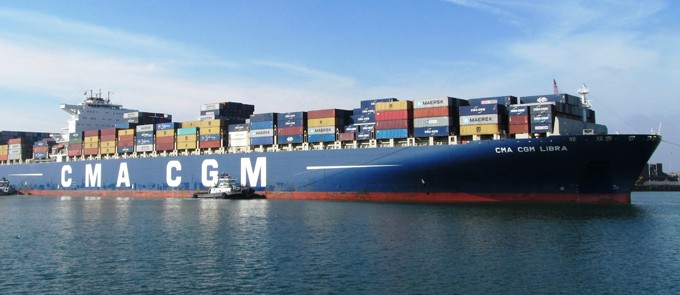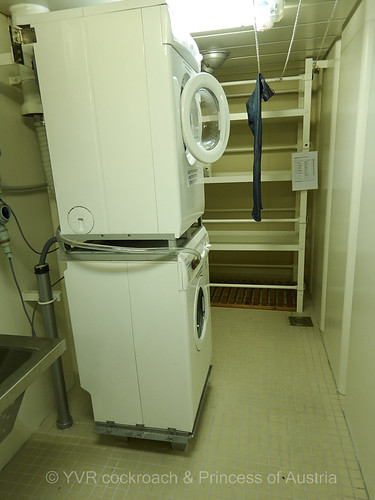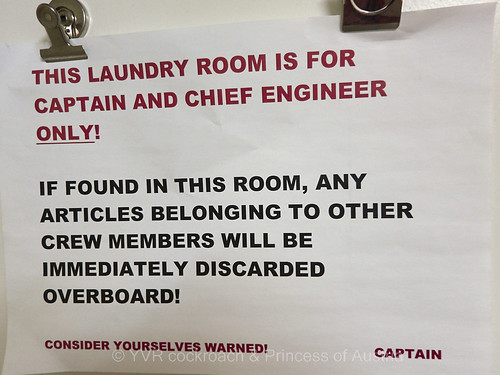The ship
 Built by Hyundai
Built by Hyundai by
yvrcockroach, maybe even made of old Ponys and Excels
Simply put, the CMA CGM Libra is huge, as are her 8 sister ships. Built by Hyundai and delivered in 2010, she is just about 364m (1,200’) long, 45.6m (150’) wide with a draft of some 15.5m and rated at 11,388 TEUs, though that is almost half the size of the newest container ships (additions to the CMA CGM fleet since include the newly-delivered China-built CMA CGM Benjamin Franklin (~18,000 TEUs) with CMA CGM Kerguelen and Georg Forster (above 17,000 TEU) and CMA CGM Marco Polo, Alexander von Humboldt and Jules Verne (16,000 TEUs), all of which have been delivered in the past 3 years. Some in the Maersk Line are even larger.
Despite her mid size, the Libra is as long as the world's largest cruise ship, RCI's Oasis class, with a beam just a couple of metres shy.
In most of her 16 forward hold halves, the Libra can stack 40’ containers up to 10 high – so that’s 85’ in depth and 16 abreast (over 128’ in hold width). Once the 32 tonne deck plates (weight of 16 average cars each) have been put in place (to prevent flooding) – 4 for half hold, 8 for each hold - the Libra can hold containers 18 abreast above deck and up to 8 high near and behind the accommodation, (6 high forward to facilitate forward view from the bridge). 45’ containers can only be stacked from the 4th level above deck and up. The ship weighs some 40,000 tonnes empty and has a maximum weight of 130,000+ tonnes so it can carry some 90,000 tonnes of cargo and fuel. By comparison, cruise ships displace much less and their tonnage is calculated on volume. I estimate that if you assume each cruise ship passenger weighs 300 lbs with bags, 1,000 only make up the weight of 4-5 fully-loaded 40’ containers. Add 2-3 containers of staff for every 1,000 passenger.

The CMA CGM Libra
For better fuel economy, the ship – like most freighters - does not have stabilisers unlike a cruise or passenger ship, or even older cargo ones. The engineers tell me the ship hull is designed so that stabilisers are not needed (flat bottom hull) yet it can roll in excess of 25 degrees either way in a storm when even the sailors can’t sleep. So far, the ship’s rough seas performance seems fine. I’ve rigged my own accelerometers out of ping pong balls for the ship isn’t rolling and pitching enough for them to work.
The heavy/bunker oil fuel tanks on the Libra are also equally impressive – 15,000 cubic meters or enough to fill 221 standard 40’ containers. As Russian bunker oil is of good quality and cheap, ships of the Pearl River Express (and probably also the Columbus Loop and other lines) periodically head for (Magadan) to refuel. Not the closest refuelling stop but the tanks are so big that the ships do not have to refuel (tanks are never completely filled anyway) for 3 months or more, and can travel across the north Pacific at least 5-6 times, on a not 100% full tank. All this while burning 300 tonnes daily at 40-41 km/h cruise speed.
Burning heavy oil means there is soot, something you’ll also see on cruise ships too when they are not in E.U. or U.S. territorial waters (or within a certain number of miles, 50-200?, of). The soot sometimes falls on the ship which is a source of grime and soot. Somethings it’s just a dry ash but sometimes it’s oily. No horde of seamen to keep it all clean as on a cruise ship (and sometimes, even they don’t).
The crew
CMA CGM crews its ships well with more officers than some. The officer list consists of the Captain a.k.a. master, the Chief Officer (a.k.a. chief mate), 2 2nd Officers (we had 3 on this trip), a 3rd Officer (the one who does the paperwork and is primarily in charge of safety and, oddly, the one to take command of the vessel should both the Captain and chief mate become incapacitated), the Chief Engineer (just about the same in rank to the Captain) and the 2nd, 3rd and 4th Engineers, Electrician (necessary for the circuits onboard ship), a Reefer man (electrician in waiting and not officially an officer) whose sole job is to check that the reefers maintain temperature (I’ve heard tolerance is +/- 0.5-1 degree C) and fix them if not, and for this voyage a cadet electrician.
If you wanted to know what the officers do, a sailor friend of mine who is now a master said, “The (captain) makes all the decisions, the (chief officer) runs the ship, the (second officer) steers the ship and the (third officer) does all the paperwork.”
Currently, the profession is still predominantly male domain though some countries such as Croatia apparently have a significant proportion of women in marine academies. Croatia however does have an extensive coastal ferry system which may lend itself to daily or overnight rotations.
The crewman are the Bosun (chief crewman), Electrical Fitter, Deck Fitter, 3 each of Able and Ordinary seaman (the sailors) and 2 Oilers (engine room crew), with the Chief Cook and Messman (a.k.a. steward), for a total of 13 rounding up the complement for a total of 24 officers and crew ordinarily. There are cabins for 16 Crew members which indicates how lean crewing has become. The ship still has designated cabin listings for Petty Officer, Motorman and Mechanic but their roles are absorbed or redundant.
Crew accommodation is generous – partly due to the space resulting from the required height of the accommodation for the bridge view - but organised by hierarchy. The Captain and Chief Engineer have the best cabins, with a large day/office and bed room suite each on the deck below the bridge (G deck) which also houses the administrative office and archive room for charts and logs. They have mounted desktop computers and I am sure they can monitor the ship, engine and all systems from there as well as do their paperwork. There is a designated cabin for a pilot probably just for the Suez and Panama canal transits. There are a couple of small cabins on the F deck, where the passenger cabins are located, for extra officers and cadets with one labelled for the “spare officer” and the other “supercargo”. Empty passenger cabins are also used for newly-boarding officers when there’s an overlap in rotation.
E deck is where most of the remaining officers are accommodated, with D and C deck for the crew – all have relatively-spacious individual cabins with windows and private bathrooms. C deck also houses the pool and palestra (the term “gymnasium” should not be used as there is no nakedness as the Greek-derived name implies), and the Officer lounge. The officers’ lounge is connected to the mess on B deck by a spiral stair case.
The galley is inbetween the two messes (crew lounge is located adjacent to the crew mess) and a spiral staircase leads down from there to A deck where the food and drinks stores are located, as are general laundry facilities. U or upper deck is the main deck and has the crew change room as well as the ship’s office. Upper deck is so named as there are at least ten decks below; one for every 8’6” of standard container height.

by
Laundry room on F deck. Reluctantly shared by the Captain and Chief Engineer with the passengers
A surprising number of laundry machine pairs for personal use are available. There’s one on F deck for the captain and chief engineer (as well as passengers), 3 on E deck and one on D deck. I think the captain and chief engineer resent passengers. The ship’s laundry is a separate facility with, presumably, a machine dedicated to dirty coveralls.
 They resent us
They resent us by
Working conditions aren’t too bad with most of the crew having 12 hour days and a solid 12 hours between shifts, though the Able Seamen may have the same shifts as the 2nd officers (4 on, 8 off). The Messman has longer days, starting at 0600 and ending at 1930 but he also has 3 hours of breaks inbetween.